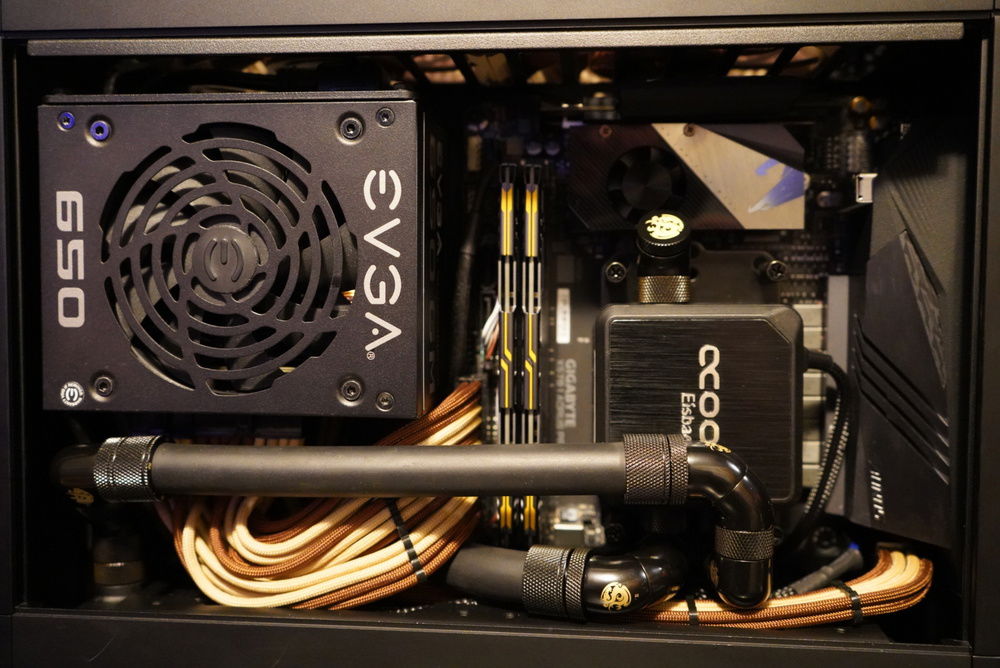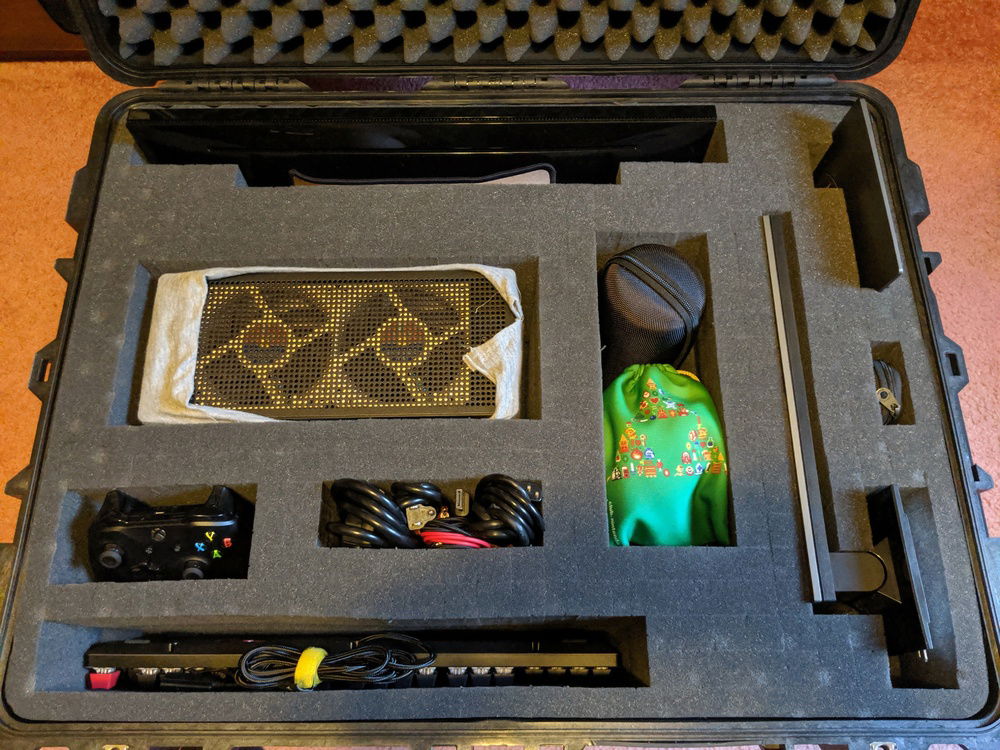Silicon Messiah
So after months of using a rather decent gaming laptop for my road job, I decided that I wanted to build a mITX system to take with me instead. After seeing Jay's (JayzTwoCents) video on the Louqe Ghost S1, I had to have it. Unfortunately, they weren't readily available when this idea popped into my head. My next choice was the Fractal Design Node 202. I figured I could make it work with a low profile CPU cooler and a blower style card. I didn't want to sacrifice any power in the name of SFF, so I decided on the AMD Ryzen 9 3900X and a 2080Ti. The more research I did, the less likely it was looking that I was actually going to be able to make it work, however. Then comes along a Reddit post about Ghost S1 availability on Amazon.
After much flip flopping on color choice and configuration, I landed on the Ghost S1 in the Ash flavor and paired it with two Tophats, one Large and one Medium. Since air cooling the 3900X was pretty much a no go, I went the AIO route with the Fractal Design Celsius S24. It was included in Louqe's own testing and was listed as the best option, albeit with some caveats. It allowed for the cleanest install, but the tubes were a little problematic with the side panel due to the fact that they aren't on swiveling 90 degree connectors like a lot of other AIOs on the market. However, with some creative ziptie placement I was able to fix that in a hurry.
When doing the test fit for all of my components, I used the stock cables that came with the PSU and what a hideous mess that turned out to be. I was planning on going CableMod again, but then while perusing Reddit I came upon a company called pslatecustoms that specializes in SFF cables. I ultimately went with them because they account for the bend radius in the cables by using different lengths to achieve the curve. Sorry CableMod! I am a traitor, I know...
The next hurdle was the GPU. I had already purchased an EVGA RTX 2080Ti Blower and had it in hand for the build, due to my initial choice of the Node 202. I was actually surprised to find that it was a pretty solid thermal performer, the main caveat being that it was one very loud boi. It didn't help that the frequency wasn't exactly the greatest either due to it being a lower bin compared to the rest of EVGA's 2080Ti offerings. That being the case, I decided to take a crack at EVGA's Step-Up program. As luck would have it, the one 2080Ti on their curated list for Step-Up eligible products was their XC Gaming variant. A better bin, and a two slot dual axial cooler for better thermals, and lower noise. After about two months of waiting, I was finally approved. I paid the difference and awaited the shipping notification. The shipping notification came, as well as an auto registration email for the new serial number. In a random turn of events, EVGA took it upon themselves to upgrade me to the XC Ultra (triple slot) variant of the card, not knowing that the use case was limited to two slots maximum. Luckily, this is EVGA we're talking about here. After bringing this to their attention, they quickly got the correct card shipped as soon as they got them into their warehouse.
My initial plan for my fan configuration was to have the bottom two on the radiator pulling air in from under the case, and then having the top fans set to exhaust in a sort of turbo charged stovepipe configuration. This was done in the interest of not having any of the heat from inside the case being pumped out through the radiator. With the blower card this wasn't really an issue. CPU temps were great given the SFF nature of the build and the GPU capped out at about 73C, albeit with the fan at 100%. After getting the XC Gaming in there, this was no longer the case. Almost immediately due to the way the cooler inherently functions compared to a blower cooler, I was hitting the low 80s. The bottom intake fans were just forcing the hot air that the GPU cooler was trying to displace back into the cooler. So I had to make a change. I had read that the Ghost was designed to excel in negative pressure setups by taking cool air in from the sides and use the top/bottom vents for exhaust. So I decided to give that a go. The GPU runs much cooler hovering in the mid to high 60s, and the CPU has only been affected by a few degrees in the worst case. A worthwhile trade off all things considered. Just for a point of reference, here are the temps I'm seeing now across multiple use cases.
CPU Idle: 30-36C (ambient temp dependent)
CPU Gaming: 50-65C (title dependent)
CPU Stress: 72C (Cinebench R20 Loop Test)
GPU Idle: 32-35C
GPU Gaming/Stress: 65-70C (title dependent)
Since this is a traveling system, I wanted to have something that I could transport the entire setup in while also keeping it safe. For this, I went with the Pelican 1630 case. Overkill doesn't even begin to describe this thing, but when your talking about this kind of investment you really can't be too careful.
In the end, this build goes to show that you don't necessarily need to have a massive setup to get massive performance. So with all of that fun out of the way, what you see in the pictures is the final product. Enjoy.
After much flip flopping on color choice and configuration, I landed on the Ghost S1 in the Ash flavor and paired it with two Tophats, one Large and one Medium. Since air cooling the 3900X was pretty much a no go, I went the AIO route with the Fractal Design Celsius S24. It was included in Louqe's own testing and was listed as the best option, albeit with some caveats. It allowed for the cleanest install, but the tubes were a little problematic with the side panel due to the fact that they aren't on swiveling 90 degree connectors like a lot of other AIOs on the market. However, with some creative ziptie placement I was able to fix that in a hurry.
When doing the test fit for all of my components, I used the stock cables that came with the PSU and what a hideous mess that turned out to be. I was planning on going CableMod again, but then while perusing Reddit I came upon a company called pslatecustoms that specializes in SFF cables. I ultimately went with them because they account for the bend radius in the cables by using different lengths to achieve the curve. Sorry CableMod! I am a traitor, I know...
The next hurdle was the GPU. I had already purchased an EVGA RTX 2080Ti Blower and had it in hand for the build, due to my initial choice of the Node 202. I was actually surprised to find that it was a pretty solid thermal performer, the main caveat being that it was one very loud boi. It didn't help that the frequency wasn't exactly the greatest either due to it being a lower bin compared to the rest of EVGA's 2080Ti offerings. That being the case, I decided to take a crack at EVGA's Step-Up program. As luck would have it, the one 2080Ti on their curated list for Step-Up eligible products was their XC Gaming variant. A better bin, and a two slot dual axial cooler for better thermals, and lower noise. After about two months of waiting, I was finally approved. I paid the difference and awaited the shipping notification. The shipping notification came, as well as an auto registration email for the new serial number. In a random turn of events, EVGA took it upon themselves to upgrade me to the XC Ultra (triple slot) variant of the card, not knowing that the use case was limited to two slots maximum. Luckily, this is EVGA we're talking about here. After bringing this to their attention, they quickly got the correct card shipped as soon as they got them into their warehouse.
My initial plan for my fan configuration was to have the bottom two on the radiator pulling air in from under the case, and then having the top fans set to exhaust in a sort of turbo charged stovepipe configuration. This was done in the interest of not having any of the heat from inside the case being pumped out through the radiator. With the blower card this wasn't really an issue. CPU temps were great given the SFF nature of the build and the GPU capped out at about 73C, albeit with the fan at 100%. After getting the XC Gaming in there, this was no longer the case. Almost immediately due to the way the cooler inherently functions compared to a blower cooler, I was hitting the low 80s. The bottom intake fans were just forcing the hot air that the GPU cooler was trying to displace back into the cooler. So I had to make a change. I had read that the Ghost was designed to excel in negative pressure setups by taking cool air in from the sides and use the top/bottom vents for exhaust. So I decided to give that a go. The GPU runs much cooler hovering in the mid to high 60s, and the CPU has only been affected by a few degrees in the worst case. A worthwhile trade off all things considered. Just for a point of reference, here are the temps I'm seeing now across multiple use cases.
CPU Idle: 30-36C (ambient temp dependent)
CPU Gaming: 50-65C (title dependent)
CPU Stress: 72C (Cinebench R20 Loop Test)
GPU Idle: 32-35C
GPU Gaming/Stress: 65-70C (title dependent)
Since this is a traveling system, I wanted to have something that I could transport the entire setup in while also keeping it safe. For this, I went with the Pelican 1630 case. Overkill doesn't even begin to describe this thing, but when your talking about this kind of investment you really can't be too careful.
In the end, this build goes to show that you don't necessarily need to have a massive setup to get massive performance. So with all of that fun out of the way, what you see in the pictures is the final product. Enjoy.
Color(s): Beige Black Brown
RGB Lighting? Yes
Theme: Color
Cooling: AIO Cooling
Size: Mini-ITX
Type: General Build
Build Updates
AIO > Custom Loop
Hardware
CPU
$ 199.99
Motherboard
$ 400.20
Memory
Graphics
Storage
$ 179.00
PSU
$ 299.99
Case
$ 272.05
Case Fan
$ 139.80
Cooling
$ 174.69
Keyboard
$ 171.97
Mouse
$ 77.00
Approved by:







